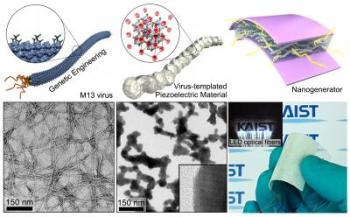Dec 4 2013
A research team led by Professor Keon Jae Lee and Professor Yoon Sung Nam from the Department of Materials Science and Engineering at KAIST has developed the biotemplated design of flexible piezoelectric energy harvesting device, called "nanogenerator."
 First row: Schemes of each step to explain biotemplated nanogenerator fabrication by using genetically engineered virus. Second row: Electron microscopy of each step in biotemplated synthetic processes and digital photograph of the flexible biotemplated nanogenerator. Right inset shows the driven LED optical fibers by the energy harvester. Credit: KAIST
First row: Schemes of each step to explain biotemplated nanogenerator fabrication by using genetically engineered virus. Second row: Electron microscopy of each step in biotemplated synthetic processes and digital photograph of the flexible biotemplated nanogenerator. Right inset shows the driven LED optical fibers by the energy harvester. Credit: KAIST
Nature has its own capabilities to spontaneously synthesize and self-assemble universal materials with sophisticated architectures such as shells, sea sponges, and bone minerals. For instance, the natural sea shell, consisting of calcium carbonate (CaCO3), is very rigid and tough whereas the artificial chalk made by the same material is fragile. In addition, most of artificial syntheses are performed under toxic, expensive and extreme environments in contrast to the natural syntheses, which are processed in benign and mild surroundings. If human can mimic these biological abilities, a variety of ecological and material issues can be solved.
The KAIST team modified a M13 viral gene, which is harmless to human and widely exist in nature, to utilize its remarkable ability of synthesizing a highly piezoelectric inorganic material, barium titanate (BaTiO3). By using this biotemplated piezoelectric material, a high-output flexible nanogenerator could be fabricated with an enhanced performance. The flexible piezoelectric nanogenerator that converts mechanical energy of tiny movements into electrical energy is an attractive candidate for the next generation energy harvesting technology. This biotemplated nanogenerator will drive commercial LCD screens and LED bulbs by simple finger movements.
Professor Lee said, "This is the first time to introduce a biotemplated inorganic piezoelectric material to a self-powered energy harvesting system, which can be realized through eco-friendly and efficient material syntheses."